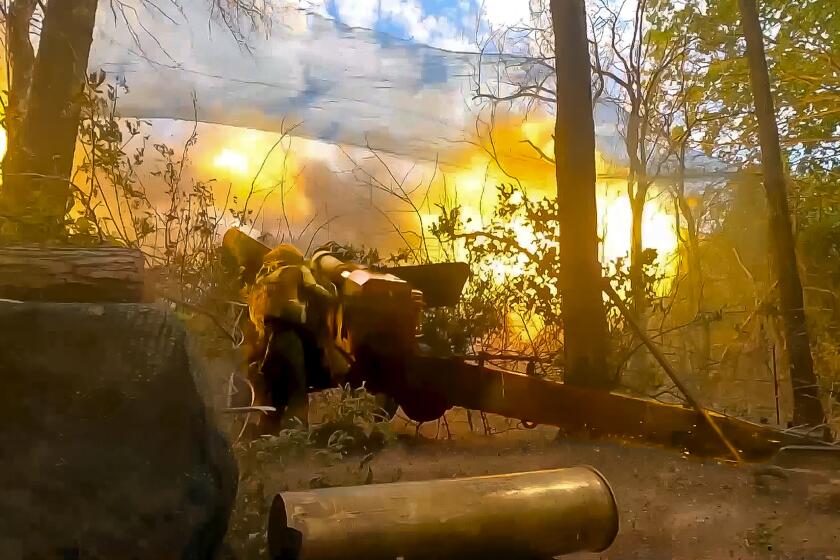Screams of ‘Fire!’ Filled ValuJet Cabin Before Crash
Passengers’ terrified shouts of “Fire! Fire! Fire!” echoed from the smoke-filled cabin as flames spread rapidly through a ValuJet airliner over the Florida Everglades last May, transcripts of cockpit recordings revealed Monday.
“We need oxygen!” a flight attendant shouted to the cockpit crew. “We can’t get oxygen back there!” The passenger cabin, she said, was “completely on fire.”
The co-pilot radioed air traffic controllers, requesting an immediate return to Miami International Airport, from which the jet had taken off about seven minutes earlier. He quickly amended his request, asking for the “closest airport available.”
But it was too late.
About two minutes later, the jet crashed into the murky swamplands about 20 miles northwest of Miami, killing all 110 on board.
Transcripts of the cockpit voice recordings were released as hearings began here Monday in an effort to shed further light on how the accident occurred.
The precise cause of the crash has yet to be determined officially, but National Transportation Safety Board investigators have said for some time that the suspected culprit is a load of more than 140 oxygen generators in the forward hold of ValuJet Flight 592.
In normal use, the generators--each of them a canister about the size and shape of a beer can--are installed in the ceiling above the passenger compartment. When activated, chemicals within each canister react to release oxygen for masks that can be used by passengers in the event of sudden and unexpected decompression.
The reaction generates a good deal of heat--as much as 500 degrees Fahrenheit--but when installed in the ceiling, the canisters are shielded and insulated.
On Flight 592, 144 canisters--many of which were still filled with highly reactive chemicals--were being carried as cargo, apparently stacked in boxes atop aircraft tires also being carried as freight.
Michael Block, an official of SabreTech, a firm that does contract repair work for ValuJet, testified Monday that the outdated canisters, which had been removed from another ValuJet plane, had been incorrectly tagged as repairable. Block said a stock clerk had then compounded the error, assuming that the tag meant they had already been activated. The stock clerk mistakenly directed a shipping clerk to label them “empty.”
The NTSB says the canisters in the hold were neither shielded nor insulated and lacked safety caps--required under federal shipping rules--that could have prevented their activation. Canisters containing the chemicals are classified as hazardous materials, and ValuJet was not authorized to carry hazardous cargo.
Either before or after the twin-engine DC-9 jetliner lifted off from Miami on May 11 for a scheduled flight to Atlanta, at least one of the canisters apparently tumbled from its box, detonating a built-in percussion cap that set off the oxygen-generating reaction, investigators said. The first reaction apparently triggered others, flooding the hold with oxygen, heated by the chemical reactions.
Investigators believe that in that oxygen-rich, superheated atmosphere, the tires in the hold burst into flame. The blaze spread upward toward the passenger compartment and cockpit.
The cockpit recordings released Monday reveal that about five minutes after takeoff, the pilot, Candalyn Kubeck, heard an unfamiliar noise.
“What was that?” Kubeck asked.
“I don’t know,” co-pilot Richard Hazen replied.
“We’ve got some electrical problem,” Kubeck said. “We’re losing everything. . . . We need to go back to Miami.”
Seconds later, passengers’ shouts of “Fire! Fire! Fire!” and “We’re on fire! We’re on fire!” can be heard through the cockpit door.
Hazen radioed controllers: “Uh, 592 needs immediate return to Miami.”
“What kind of problem are you having?” a controller asked.
“Smoke in the cockpit . . . smoke in the cabin,” Hazen told him.
The sound of rushing air indicates someone in the cockpit opened a window in an apparent effort to clear the air.
“We need the, uh, closest airport available,” Hazen told controllers.
“They’re gonna be standing by for you,” a controller replied.
For more than a minute, the voice recorder shut down, apparently indicating a loss of electrical power on the plane. The recorder started up again and ran for a few seconds, shut down, started up once more and then fell silent.
Radar data show that the airliner went into a steep dive, plunging more than 6,000 feet in about 30 seconds. The plane leveled off somewhat and then arced down into the swamp, disappearing below the surface of the water.
Whether the crew was overcome by smoke that may have been toxic, and whether the plane’s control systems failed, have not been determined.
In the days that followed the accident, concern mounted about the safety of no-frills airlines like ValuJet, which at the time was already undergoing a special Federal Aviation Administration review because of repeated safety problems.
Assurances then by Transportation Secretary Federico Pena that ValuJet was a “safe airline” did little to reassure critics.
There were renewed complaints that the FAA, which operates under Department of Transportation supervision, was slipshod in its inspections of airline equipment, lax in enforcing its own rules and slow to order changes that might save lives.
David Hinson, then-administrator of the FAA, eventually conceded that his agency had been slow to crack down on ValuJet’s maintenance problems. But he said those shortcomings had nothing to do with the crash.
ValuJet cut back its flights, then was grounded altogether on June 17 after an intensified FAA inspection uncovered “several serious deficiencies” in the airline’s operations.
ValuJet resumed limited operations in October after receiving a clean bill of health from the FAA.
More to Read
Start your day right
Sign up for Essential California for news, features and recommendations from the L.A. Times and beyond in your inbox six days a week.
You may occasionally receive promotional content from the Los Angeles Times.






